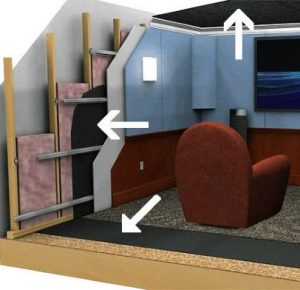Introduction
Soundproofing is the act of eliminating sound transfer from one space to another. Soundproofing involves adding mass and density to a shared boundary to create sonic separation. Soundproof walls, doors, windows, floors and even ceilings are becoming an essential part of our modern world. Whether it’s a soundproof window insert, soundproof interior door, soundproof wall panels or soundproof floor mat, there are material that keep your noise from your neighbors and your neighbors’ noise out. Soundproofing is an essential part of any office, studio, home theater, mixed use space and can be done during new construction or as a renovation to an existing build.
What is Soundproofing?
Soundproofing is adding mass and density to a structure to contain or block sound. In doors this could be as complex as an acoustic door, or as simple as adding an acoustic door seal kit. In walls it can be adding sound panels or building out walls with soundproof barriers like Audioseal® MLV Soundproofing Barrier or Green Glue. Whatever route you go, soundproofing involves adding a product that increases the mass and density of the wall, door, or other surface and covering that surface with your material 100%.
Why is Soundproofing Important?
Soundproofing works both ways — it keeps your neighbors’ noise out, and your noise in. It is important because a properly soundproofed office, home, or other space will allow the user to have confidential conversations, record without interruption, use louder dB products on their schedule. Sound moves like water, so any opening will lead to sound leaking to adjacent spaces. Unlike water, sound is not limited by physical mass, so a 1% opening will offer a 50% sound leakage. Soundproof homes allow folks on different schedules to coexist, home offices to function undisturbed to the rest of the home, and for the homeowner to keep from disturbing neighbors or even noise violations. A soundproof business will allow business hours at all hours, uninterrupted business flow, confidential meeting spaces, and premium resale value.

Examples of sound barriers in ceilings, floors, and walls
Examples of Soundproofing Materials
Examples of Soundproofing materials include:
- AudioSeal® Mass Loaded Vinyl (MLV) Soundproofing Barrier
- Green Glue
- Clearsonic Isolation Enclosures
- PrivacyShield® Absorptive Soundproofing Blankets
- Barrier Wall Panels
- Composite Foam Materials
- Window Inserts
Here’s a great time lapse of a soundproof wall being constructed, and another one featuring a demo of an isolation booth.
Tips and Reminders for Soundproofing
A 1% opening can lead to 50% of sound escaping, so it’s important to cover all of a shared wall or other surface
Soundproofing is blocking sound from one space to another, sound absorption is elimination of echo/reverb within a space.
Soundproofing can involve building out a surface with new building material or adding ready made products that can simply be installed over existing structures.
Summary
Think of sound proofing the way you think of a door. When a door is open anything is able to come through it, but when it’s shut things on both sides stop at the door. Soundproofing is keeping sounds from transferring from one space to the other. You need to add mass and density to a surface to soundproof, simple absorption will not do the trick. You need to cover 100% of your shared surface to effectively soundproof.
To learn more about how Acoustical Solutions can solve your noise control problems, use our contact form, call one of our Acoustical Sales Consultants at (800) 782-5742, or visit us on the web at acousticalsolutions.com.
